Introduction
VOPlot (VOTable Plotting tool) is an applet for plotting different astronomical graphs using data stored in VOTable format. VOPlot is available in desktop version and a web-based version. The web-based version is integrated with the VizieR Catalogue Service and can be used to plot any catalogue by selecting output layout as "Plot (VOPlot)". The desktop version can be downloaded from http://vo.iucaa.ernet.in/~voi/voplot.htm.
Click here for Release Notes and disclaimer information.
About VOPlot
VOPlot has been developed as a part of the Virtual Observatory - India initiative by Persistent Systems Pvt. Ltd. and the Inter-University Centre for Astronomy and Astrophysics (IUCAA), in collaboration with Centre de Données astronomiques de Strasbourg (CDS), with a support from the European AVO project. The collaboration between VO-I and CDS extends to several related projects.
VOPlot uses Ptplot 5.2, a 2D data plotter and histogram tool implemented in Java. Ptplot has been developed at EECS department at the University of California, Berkeley.
VOPlot uses SAXParser to parse VOTable documents.
Third Party Tools
- Ptplot 5.2, a 2D data plotter and histogram tool implemented in Java. Ptplot has been developed at EECS department at the University of California, Berkeley.
- VOPlot makes use of cds.astro (Astronomical coordinate manipulation) package for projection maps. The package has been developed by CDS, Strasbourg.
- VOPlot makes use of Aladin which is an interactive software tool allowing the user to visualize digitized images of any part of the sky, to superimpose entries from astronomical catalogs. It is developed by CDS, Strasbourg.
- VOPlot uses Colt package of CERN libraries for statistical calculations of the VOTable data.
Differences in Desktop and Web-based VOPlot
The desktop version has same functionality as the web-based version except for a feature for saving the plot as an EPS file or as a VOTable file. In the web-based version, there is no menu to load a VOTable, Ascii or FITS file.
Getting Started
Standalone Version:
To use the standalone version of VOPlot, you will need to download the executable jar file named voplot.jar. The file can be executed by typing the following command at the command prompt:
java -jar voplot.jar
This will open a java application window as shown in the Fig. 0. To use data from a VOTable you will need to load it first. You can specify the path of a VOTable on your personal computer (PC) by clicking on the "Load VOTable" submenu from the "File" menu. The message on the status bar will indicate whether the file was loaded successfully or not.
Note : To run VOPlot 1.3.1 you must have JRE 1.4.2 or higher installed. To see the version of JRE installed, type the following command at the command prompt:
java -version
Figure 0
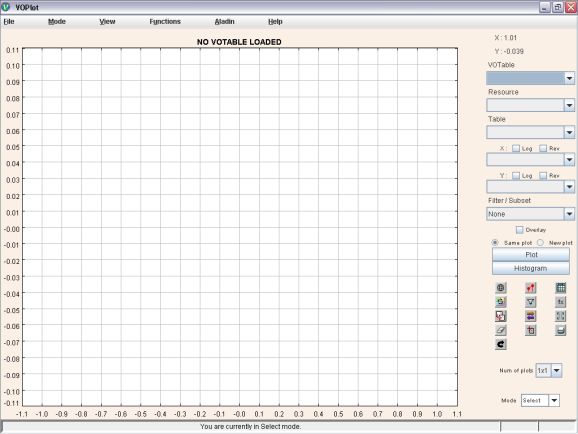
Web Version:
To use the Web-based version of VOPlot for plotting a VOTable:
Search for the required catalogue on VizieR, select a VOTable from the list and select the output layout as "Plot (VOPlot)".
- After clicking on "Submit Query" button the plotting applet loads. Note: Only numeric columns from the VOTables can be used for plotting.
- Once the applet is loaded, you can see the numeric fields listed as columns in the dropdown list box.
Figure 1
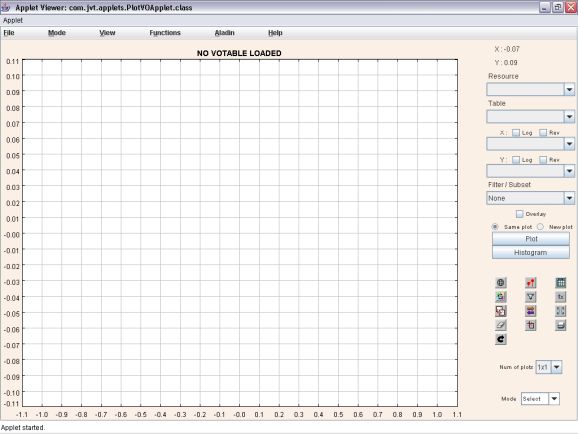
Load VOTable/ FITS /ASCII file
Load VOTable file
For loading a VOTable file click "Load VOTable File" menu item from the "File" menu. A file chooser dialog appears where you can select the desired VOTable from the local file system. Select some votable file. Clicking "Open" would load the VOTable and plot a pair of columns from the first table of first resource of the loaded votable.
Load FITS file
For loading a FITS file click the "Load FITS File" menu item from the "File" menu. A file chooser dialog appears where you can select the desired FITS file from the local file system. Select some FITS file. Clicking "Open" would load the FITS file and plot a pair of columns from the loaded FITS.All HDUs except for the primary HDU are loaded into the Table dropdown combobox.
If the FITS file has only the primary HDU an error message is popped up.
Load ASCII file
For loading a ASCII file click the "Load ASCII File" menu item from the "File" menu. A file chooser dialog appears where you can select the desired ASCII file from the local file system. Select some ASCII file. On clicking "OK" user is asked for some information before loading the ASCII file.- In the first screen user can enter line numbers for header(column names), ucds, datatypes and the line where data starts
- Clicking "OK" would show a screen where a delimiter is selected.
- Clicking "OK" would show the meta data and data from the ASCII file. Metadata(Column names, datatypes..) shown is editable.
Sample screens are shown below
Figure 2
Cone Search
Load VOTable from ConeSearch
Click the "ConeSearch" menu item from the File menu. A dialog opens which lists out the available cone search services. One can enter the object name in the "Object Name" text box and click Resolve for obtaining corresponding RA, DEC or type the RA, DEC values directly in the text boxes.The OK buttons gets enabled when a cone search service is selected. Clicking OK would fetch a VOTable and show a tabular representation of the metadata and data. User can save or load the data.
ConeSearch using the selected point
If we have a single point selected on the scatter plot, one can do cone search using the RA, DEC values related to the selected point. To do so select a point and click the "Cone search using RA, DEC related to the selected point" menu item from the "View" menu.
ConeSearch using mouse click co-ordinates
If RA, DEC columns have been plotted on the scatter plot then cone search using the mouse click co-ordinates can be done. To do so right click on the scatter plot and click the "Cone Search using the mouse click co-ordinates" from the pop-up menu.
Cone search dialog is shown below
Figure 3
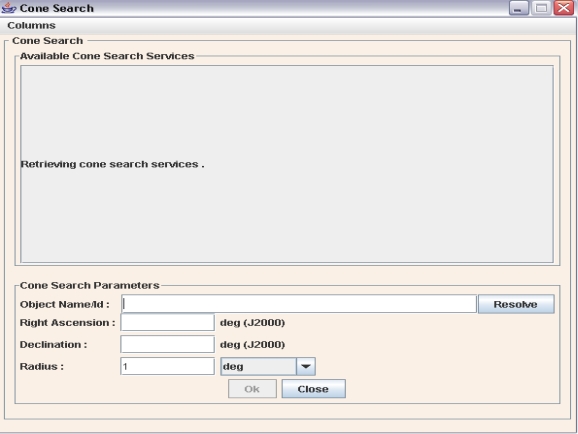
Close VOTable
To close a loaded VOTable, FITS or ASCII file select the file to be closed in the VOTable drop down combo and click "Close VOTable" menu item in the "File" menu.
To close all the loaded VOTables click "Close All VOTables" menu item from "File" menu.
Plotting Scatter Plots
To draw a plot of one column against the other,
- Select the column to be plotted on the X-axis.
- Select the column to be plotted on the Y-axis.
- Click "Plot" button.
You can see the scatter plot. If required, you can plot data points on a log scale by setting the option appropriately using the "Log" checkbox. Also, by checking the "Rev" checkbox, the data points are plotted on a reverse scale.
Scatter plot uses pixels for plotting if the number of points is more than 100000.
Figure 4

Changing Plot properties
To change the plot properties
click on the "View -> Plot Properties" menu or the plot Properties
button
![]() ,
which opens the "Set Plot format" dialog as shown in Figure 5.
,
which opens the "Set Plot format" dialog as shown in Figure 5.
For changing properties such as title, labels ranges etc., click on the "simple" tab.
Figure 5

For changing properties like color and marker style click on the "Advanced" tab.
To change the marker styles for all plotted columns click on Select marker style and color for ALL datasets.
To change marker style or color of single plotted column click on Select marker style and color for a dataset.
You can choose various marker styles such as "pixels", "points" etc. Setting the marker style to "various" allows plotting with different symbols like triangle, rectangle etc.
Figure 6

Plot with Error Bars
To draw a plot with error bars, click on the "View -> Plot with error bars" menu.
This will open the Error bars dialog. By default E_ABC(Upper case) or e_ABC(Lower case) are chosen as default columns for the error limits, where ABC is the Y-Column.
If E_ABC contains the error then the error bar is drawn between ABC - E_ABC(The lower limit of the error bar) and ABC + E_ABC(The upper limit of the error bar).
You can choose any other columns as well as for upper and lower error limits.
The Error bars dialog is shown below in Figure 7.
Figure 7
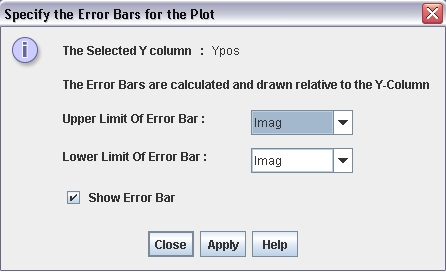
A Sample plot with error bars is shown below in Figure 8.
Note : Error bars are only provided for the column on the Y-axis.
Figure 8

Plotting Histograms
To draw the histogram of a column,
- Select the column on X-axis.
- Click "Histogram Plot" button.
A sample histogram is shown in Figure 9.
Figure 9
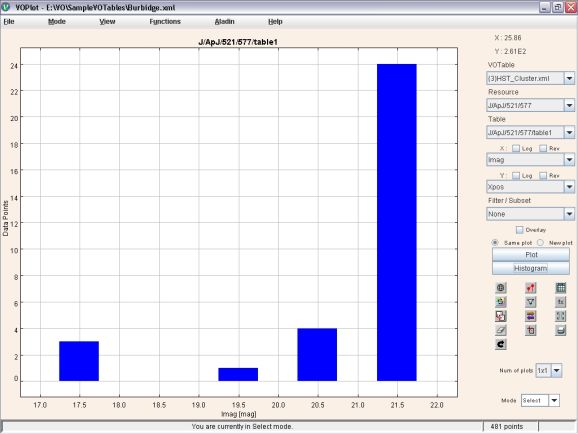
If you want to plot the histogram of data points on a log scale, then check the "Log" checkbox corresponding to the X-axis.
Changing Histogram properties
To change the histogram
properties click on the "Plot properties" button ![]() .
.
Click on the "Simple" tab to change properties like the bin width, X Label, Y Label, range, etc.
Figure 10
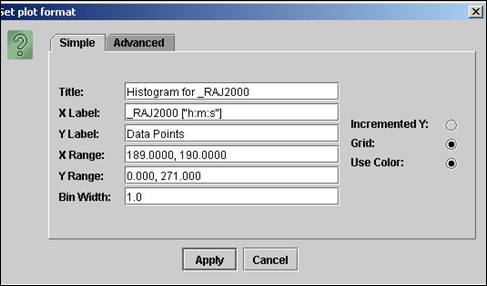
Click on the "Advanced" tab to change the color of the histogram.
Figure 11

Multiple plots in the main window
More than one scatter plot and/or Histogram can be seen in the main window as a grid. The layout of the plots can be chosen from the "Num of plots" dropdown combobox at the bottom of tool box. Clicking on a Plot makes it active (plot with orange coloured title bar). All the tool box buttons operate on the "Active Plot" . One can select any of the available plots and plot a scatter plot / histogram.
There are two radio buttons above the "Plot" Button.
If "same plot" radio button is selected all plotting operations are done on the active plot.
If "new plot radio button is selected, clicking plot(histogram) buttons draw scatter plot(histogram) in an empty plot(empty child window) . Even checking/unchecking log checkbox with new plot radio selected would plot the graph in logarithmic/normal scale in an empty plot(empty child window).
Sample figure showing multiple plots is shown below
Figure 12
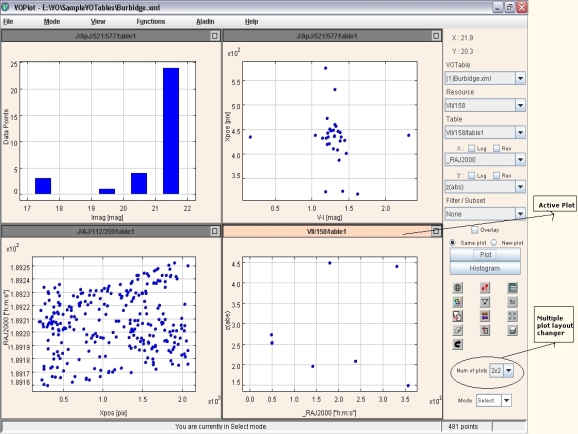
Zooming
Points can be zoom only if the plot is active
For zooming into the plot you need to be in the Zoom mode. To go in zoom mode, choose "Zoom" from "Mode" combo box or click on the "Zoom Mode" submenu from the "Mode" menu.
If the number of points for the region zoomed in is greater than 100000, pixels are used for plotting.
To zoom in, drag the left mouse button down and to
the right to draw a box around an area that you want to see in detail. To zoom
out, drag the left mouse button up and to the left. To get the original
graph click on the "Show Full Range" icon represented by
![]() .
.
Select Points
Points can be selected only if the plot is active
To take the mouse into select mode, choose "Select" from "Mode" combo box or click on "Select Points mode" submenu from the "Mode" menu.
To select points, drag the left mouse button down and to the right to draw a box, the data points that fall within the box area are selected. A square with green outline is drawn around the data point to indicate it is selected.
For multiple selections of points, press the shift key and hold it while dragging the left mouse button.
Unselect Points
To take the mouse into unselect mode, choose "Select" from "Mode" combo box or click on "Unselect Points mode" submenu from the "Mode" menu.
To unselect points, drag the left mouse button down and to the right to draw a box, the data points that fall within the box area are not selected anymore.
Clear All Selections
To clear all the selection on the plot, click on the
"Clear all" icon represented by
![]() or click on "Clear All Selections"
submenu from the "Mode" menu.
or click on "Clear All Selections"
submenu from the "Mode" menu.
Select points on other plots w.r.t Active Plot
When you have multiple scatter plots of the same VOTable you can select in one of the plots and select related points in other plots using this feature.
In the main window, to select points on other plots which are related to those selected in the Active Plot click the "Select Points on other plots w.r.t Active plot" icon
The dialog has check boxes for each plot (child window) in the main window. If a plot is empty corresponding check box is disabled. Active Plot's check box is disabled and the corresponding label is in blue colour. Select the checkboxes of plots on which you would prefer to select the points related to those in the Active plot and click "OK".
The dialog is shown in the figure below:
Figure 13

Drag selected points
When there are multiple plots in the main window. One can plot the selected points onto a another plot by dragging them.
Similar operation can be done by clicking "Plot selected points in an empty plot" icon ![]() or "Plot selected points in an empty plot" menu item in the "View" menu
or "Plot selected points in an empty plot" menu item in the "View" menu
Clear Plot
To clear the plot click the " Clear Plot " icon represented by ![]() or click on " Clear Plot " menu item from the " View " menu
or click on " Clear Plot " menu item from the " View " menu
Overlaying Plots
To overlay plots (simultaneously viewing multiple plots with similar range on the same axes system)
- Select column to be plotted on the X-axis.
- Select column to be plotted on the Y-axis.
- Click "Plot" button.
- Select column to be plotter on X-axis (represents another plot).
- Select column to be plotter on Y-axis (represents another plot)
- Set the "Overlay" option.
- Click "Plot" button.
A different marker will be used for each plot, to allow one to differentiate between the plots.
An example of overlaid plots is shown in Figure 14.
Figure 14
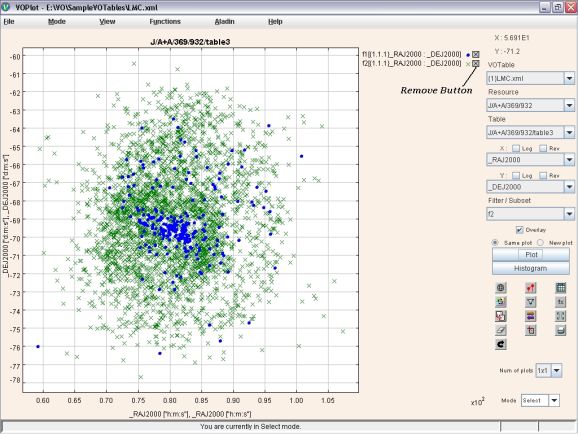
Overlaying Histograms
To overlay histograms (simultaneously viewing multiple histograms with similar range)
- Select column to be plotted on the X-axis.
- Click "Histogram" button.
- Select column to be plotted on X-axis (represents another plot)
- Set the "Overlay" option.
- Click "Histogram" button.
A different color will be used for each histogram, to allow one to differentiate between the histograms.
Example of overlaid histogram is shown in Figure 15.
Figure 15
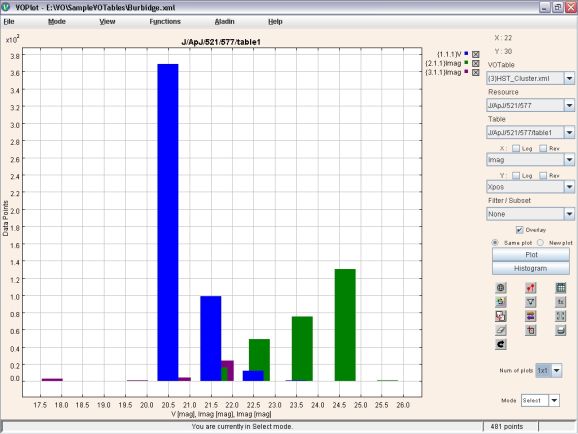
Transformations on columns
One can create new columns by defining transformations on them. You can use expressions with arithmetic operators, trigonometric functions, and miscellaneous functions shown below to create new columns. You can use transformed columns for plotting.
Operators Allowed
|
+ |
Addition |
|
- |
Subtraction |
|
* |
Multiplication |
|
/ |
Division |
Functions
|
log(a) |
Log to the base 10. |
|
ln(a) |
Natural Log of "a" with base e, where e is Euler's number (i.e. 2.718...). |
|
pow(a,b) |
"a" raised to power of "b". |
|
sqrt(a) |
Square root of "a". |
|
exp(a) |
Returns the exponential number e (i.e. 2.718...) raised to the power of "a". |
|
dexp(a) |
10 raised to the power of "a". |
|
cos(a) |
Trigonometric cosine of an angle. a = an angle in radians. |
|
acos(a) |
Computes the arc cosine of "a". "a" must range from -1 to 1; the resulting angle is in radians and will range from 0 to pi. |
|
sin(a) |
Trigonometric sine of an angle. a = an angle in radians. |
|
asin(a) |
Computes the arc sine of "a". "a" must range from -1 to 1; the resulting angle is in radians and will range from -pi/2 to pi/2. |
|
tan(a) |
Trigonometric tangent of an angle. a = an angle in radians. |
|
atan(a) |
Computes the arc tangent of "a". The resulting angle is in radians and will range from -pi/2 to pi/2. |
|
toradians(a) |
Converts an angle measured in degrees to an equivalent angle measured in radians. |
|
todegrees(a) |
Converts an angle measured in radians to an equivalent angle measured in degrees. |
Creating new columns
- To define transformations on columns click on click "Create new columns" icon
 or
"Create new columns" submenu from the "Functions" menu
to display the "Create new columns" Dialog Box.
or
"Create new columns" submenu from the "Functions" menu
to display the "Create new columns" Dialog Box. - In the "Create new virtual columns" Dialog Box, you can see the column names, UCD and their Id (used for expression building) and the expression with which they were created. All these correspond to the table selected in the Table drop down combo in main window
- For creating a new column, type in the new column name (example col2) and the expression using the functions shown above. Example: $4+log($6). Add a unit as well for the new column (Optional).
- The expression can also be formed with the help of "Operator Calculator" as shown in the following figure. When you click on a row present in the "Column Metadata" table, then the corresponding Column Id appears in the text box for "Enter expression". By clicking on any of the buttons in the "Operator Calculator", the corresponding operator or function appears in the text box for "Enter expression". This feature eliminates the need of typing in the expression and allows automatic creation of the expression.
The dialog box for creating new columns is shown in Figure 16.
Figure 16

Creating data subsets by applying filters
You can create new data subsets by defining filters on them. You can use a condition with relational operators and logical operators with operators and functions shown above to create new data subsets. Data subsets can be used for plotting.
Operators Allowed
|
< |
Less than |
|
<= |
Less than or equal to |
|
> |
Greater than |
|
>= |
Greater than or equal to |
|
== |
Equal to |
|
!= |
Not equal to |
|
&& |
And |
|
|| |
Or |
|
! |
Not |
Creating new data subsets
- To define new data subsets on columns click on the "Create Filters" icon
 or the
"Create Filters" submenu from the "Functions" menu to
display the "Create new data subsets" dialog box.
or the
"Create Filters" submenu from the "Functions" menu to
display the "Create new data subsets" dialog box. - In this dialog box, you can see the column names, UCD and their Id (used for expression building) and the expression with which they were created in the first table. The second table shows the data subsets that you previously created with their names and conditions. All these correspond to the table selected in the Table drop down combobox in main window
- For creating a new data subset, type in the new subset name (example f1Glat) and the filter definition using the functions and relational operators shown in table above. You can also make use for arithmetic operators and functions listed for "Transformations on columns". Example: $1 > 0 || ($3! = 0 && $2 > 100)
- The expression can also be formed with the help of
"Operator Calculator" as shown in the following figure. When you
click on a row present in the "Column Metadata" table, then the
corresponding Column Id appears in the text box for "Enter
expression". By clicking on any of the buttons in the "Operator
Calculator", the corresponding operator or function appears in the
text box for "Enter expression". This feature eliminates the
need of typing in the expression and allows automatic creation of the
expression.
Clicking on any of the previously created filters will copy its expression enclosed in braces into the "Enter expression" text box
The dialog box for creating data subsets is shown in Figure 17.
Figure 17

Once a data subset is created you can plot data from the subset. This can be done by choosing the data subset from the Filters combo box in the main applet window.
Note: "None" represents the complete data. Only data points satisfying the filter condition will be considered for plotting.
Creating data subsets from visible points
One can zoom on a scatter plot and create subset of the points visible. To do so click the "Create subset from visible points" in the "Functions" menu or right click and click "Create subset from visible points" in the pop-up menu.
User is asked to name the subset and the subset gets added in the filter drop down combo.
Creating data subsets from selected points
To create subset of the points selected either click the "Create subset from selected points" in the "Functions" menu or right click and click "Create subset from selected points" in the pop-up menu.
User is asked to name the subset and the subset gets added in the filter drop down combo.
Creating data subsets from points not selected
To create subset of the points not selected either click the "Create subset from points not selected" in the "Functions" menu or right click and click "Create subset from points not selected" in the pop-up menu.
User is asked to name the subset and the subset gets added in the filter drop down combo.
Statistical Functions
Applying Statistical Functions
- To apply statistical functions, click on "Generate Statistics" icon
 or
"Generate Statistics" submenu from the "Functions"
menu. The "Plot Statistics" dialog box will open.
or
"Generate Statistics" submenu from the "Functions"
menu. The "Plot Statistics" dialog box will open. - You can choose the data subs_Creating_data_subsets_seet from the filter combo box. Note: "None" represents the complete data.
- Select X, Y and Z column and click "Calculate" button. Note: Default columns are picked up from X, Y column drop down combos in the main window. The results are displayed on the same window.
The dialog box is divided into two tabs basic and advanced functions. The basic functions require only one data array, while the advanced functions require two or three data arrays as parameters.
The following statistical functions are currently supported.
|
Sr. No. |
Function name |
Input Columns |
|
1 |
Number of observations |
X |
|
2 |
Range |
X |
|
3 |
Minimum |
X |
|
4 |
Maximum |
X |
|
5 |
Mean |
X |
|
6 |
Variance |
X |
|
7 |
Standard deviation |
X |
|
8 |
Skew |
X |
|
9 |
Kurtosis |
X |
|
10 |
Linear correlation |
X, Y |
|
11 |
Significance (t) for Linear correlation |
X, Y |
|
12 |
Probability for Linear correlation |
X, Y |
|
13 |
Rank correlation |
X, Y |
|
14 |
Partial correlation |
X, Y, Z |
VOPlot, by default, takes only the only the plotted data range into consideration while evaluating the statistical functions. This will evaluate the statistical functions for the currently selected columns, along with the applied filter, if any, corresponding to the plotted points. However you can force it to consider complete dataset by selecting the "Entire Data" checkbox. Similarly, you can force it to consider the selected data range by selecting the "Only Selected Point Data" checkbox
Sample dialog box with basic tab selected showing plot statistics is shown in Figure 18.
Figure 18

Sample "Advanced Functions" tab is shown in Figure 19.
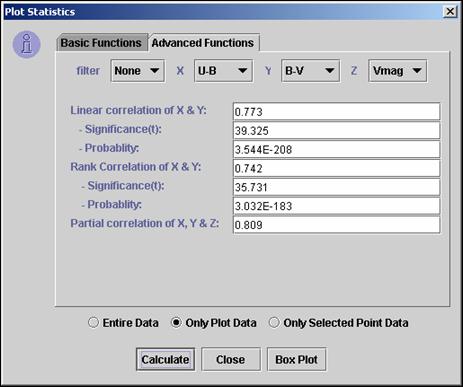
Displaying Box Plot
A Box plot provides an excellent visual summary of many important aspects of a distribution. It identifies the middle 50% of the data, the median and the extreme points.
Click on the "Box Plot" button on the "Plot statistics" dialog to display the Box Plot for the X column.
Sample Box Plot is shown in Figure 20 below.
Figure 20
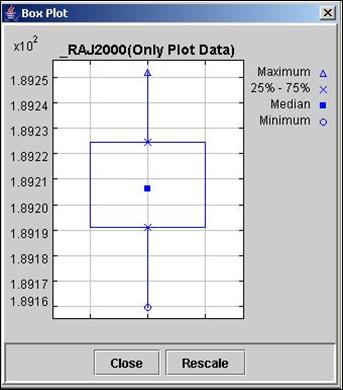
Display VOTable
Used to display Plot data in VOTable format. It also displays the filters and data sets that are user-defined.
Displaying the VOTable:
To view the VOTable, click on "Data in VOTable format" submenu from the "View" menu. The "Display VOTable" dialog box will open.
The dialog has VOTable, Resource and Table drop down combo box. By default the first table of first resource of first votable loaded would be selected and the corresponding VOTable is shown. If the table has been plotted in the active plot of the main window with some points selected then only data related to those points are shown.
You can select the table for which VOTable is to be displayed from the combo boxes and click the show button. The filter combobox can be used to only see data corresponding to a subset/filter created previously
Selected Data:
On selecting "Display Data Of Selected Points" check box you see data related to the selected points in the active plot of main window. Unchecking would show all the data
Note: The data displayed is truncated to the first hundred points.
Sample dialog box displaying VOTable containing data of selected points is shown in Figure 21 below.
Figure 21

Entire VOTable:
On selecting the " Display all resources and tables check box selecting the checkbox " all the resources and tables of the VOTable selected in the VOTable combo box are shown.
Note: The data displayed is truncated to the first hundred points.
Save VOTable:
This feature is available only in the desktop version of VOPlot. To save a VOTable, click on "Save As File" button on the dialog box. The save as dialog box will appear. Select a file and click on OK. The file is saved as an XML file, VOTable format. The various user-defined filters and data columns pertaining to all points (more than 100) are saved in the file.
Note: This feature is not available in the web-based version of VOPlot. There is no "Save As File" button on the dialog box as shown in Figure 22 below.
Figure 22
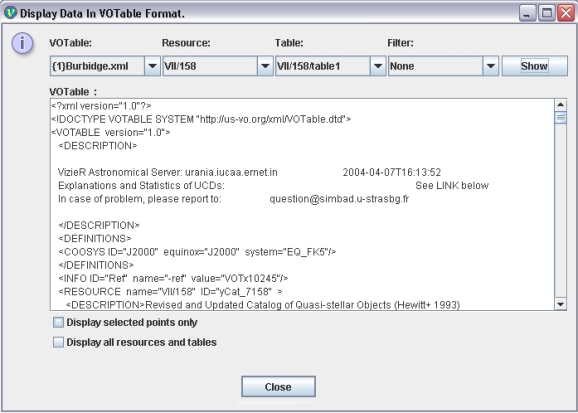
Display Data as Table
The VOTable data used to plot the graph can be displayed in tabular format. It also displays the filters and data sets that are user-defined.
Displaying the VOTable Data in Tabular Format :
To view the
VOTable data, click on "Data in Table format" submenu from the
"View" menu or "Data in Table format" icon ![]() .
The "Display Data" dialog box will open.
.
The "Display Data" dialog box will open.
The dialog box has VOTable, Resource, Table combos and filter combos. By default the first table of the first resource of the first VOTable loaded is selected. The data is displayed in two different tables. The first table displays the field metadata of the VOTable, while the second table displays the actual data. If the table has been plotted on the active plot of the main window with some points selected then only the data related to the selected points is shown.
To see the data of the VOTable of your choice you can change the selections in the combo boxes and click on the "Show" button.
You can use the filter combobox to select a subset. Clicking show will show data in that subset only
Sample dialog box displaying the selected data and metadata of the VOTable is shown in Figure 23.
Figure 23

Selected Data:
To view the data of the points selected on the active plot select the radio button "Show Selected".
Entire Data:
To view the data of all the points select the radio button "Show all".
Display Data in CSV Format
To view the VOTable data, click on "Data in CSV format" submenu from the "View" menu. The "Display Data in ASCII Comma separated Format" dialog box will open.
The dialog box has VOTable, Resource, Table and filter combo boxes. By default the first table of the first resource of the first votable is selected. The data is displayed in Comma separated values (CSV) Format. The first row gives the Column Names for the Data and the subsequent rows give the actual data. If the table has been plotted on the active plot of the main window with some points selected then data related to the points selected are only shown. If points are not selected on the plot, the entire plot data is displayed.
Sample dialog box displaying the data of the VOTable in CSV Format is shown in Figure 24.
Figure 24
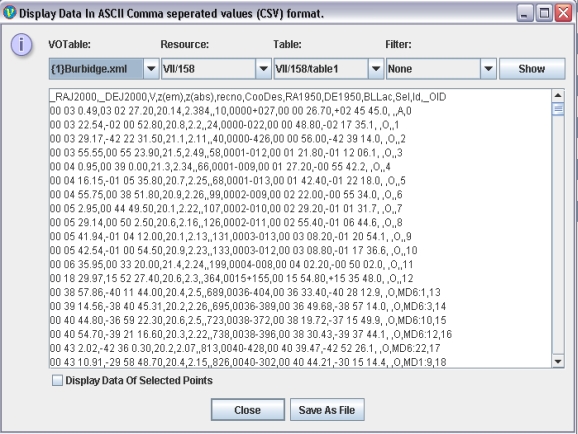
Selected Data:
To view the data of the points selected in the active plot of main window select the Checkbox "Display Data of Selected Points".
Entire Data:
To view the data of all the points unselecting the CheckBox "Display Data of Selected Points".
Save Data:
This feature is available only in the desktop version of VOPlot. To save the CSV data, click on "Save As File" button on the dialog box. The save as dialog box will appear. Select a file and click on OK. The file is saved as an CSV file. This file can be opened in any spreadsheet software (e.g Microsoft Excel) for viewing/editing.
Note: This feature is not available in the web-based version of VOPlot. There is no "Save As File" button on the dialog box.
Display Projection Plot
The stars on the celestial sphere are like cities on the globe. While a globe is the most accurate representation of geography, it is difficult to carry around. We have invented flat representations of the globe that, although they distort shapes, areas, and directions are a whole lot easier to carry around. Projections are mappings from this 3D space to a 2D space.
The projection plot for the data plotted in VOPlot can be seen by clicking on "Spherical Projection Plot" submenu from the "View" menu or the projection plot
Button ![]() .
.
For every VOTable loaded in VOPlot there will be a corresponding dataset in the projection plot. Selecting/Unselecting points in the projection plot will also select corresponding points in the main plot and vice versa.
Projection plot is kept in sync with the active plot of main window
The following 3 types of projections are provided:
- Sinusoidal/Sanson Projection
- Aitoff/Hammer Projection
- Mollweide Projection
Changing the type of Projection:
The projection type change can be changed by selecting the projection type from the "Projection type" combo box from the projection plot dialog.
Changing the Center of Projection:
The center of projection is the coordinates of the center point of the projected sphere. We can see the projected points from different positions such as "Standard", "North Pole" and "South Pole" by changing the center of projection. The center of projection can be changed by selecting the center type from the "Center" combo box.
A sample Projection Plot for the above the three projections is shown in Figures 25, 26 and 27 respectively:
Sinusoidal Projection:
Figure 25
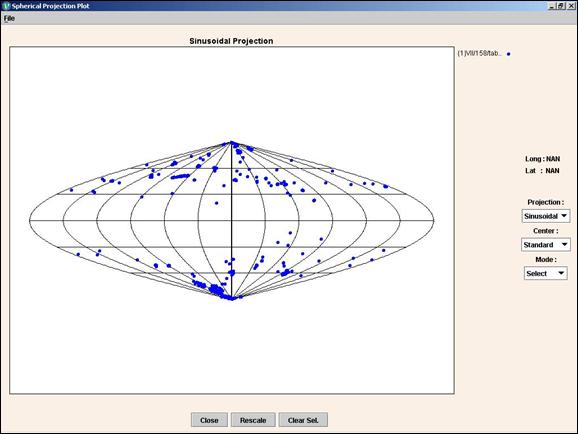
Aitoff Projection:
Figure 26

Mollweide Projection:
Figure 27

Saving plot as EPS
In the standalone version of VOPlot, for saving the active plot as an EPS, click on "Save Graph As EPS" submenu from the "File" menu. The save as dialog box will appear. Select a file and click on OK to save the image as an EPS file onto your machine. Currently, the image can only be saved as an EPS file.
To save all the plots shown in the main window click on "Save All Graphs As EPS" submenu from the "File" menu.
Note: Save as EPS features are not available in the web-based version of VOPlot.
Printing plot
For printing the active plot click on "Print Graph" icon ![]() or the "Print Graph" submenu from the "File" menu.
or the "Print Graph" submenu from the "File" menu.
For printing all the plots click on "Print All Graphs" submenu from the "File" menu.
Invoking VOPlot with programmatic interface
The interface provides methods to launch VOPlot from another java application and to manipulate VOPlot.
In VOPlot1.3.1 the API loadVOTable(InputStream stream, boolean loadMultiple) has been replaced by two new APIs
loadVOTable(File file, boolean loadMultiple) loads VOTable from a file
loadVOTable(URL url, boolean loadMultiple) loads a VOTable from a url
Click here to see sample java program that invokes VOPlot using "VOPlotExternalApp" interface.
Launch Aladin
Aladin is an interactive software sky atlas allowing the user to visualize digitized images of any part of the sky. It has been developed by Centre de Donneés astronomiques de Strasbourg, France. Please visit http://aladin.u-strasbg.fr/ for more information on Aladin.
Aladin uses the same data that is loaded in the active plot of VOPlot. Click on "Launch Aladin " submenu of "Aladin" menu to invoke Aladin. An instance of Aladin will appear as shown in Figure 28 below.
Aladin kept in sync with the active plot of main window
Figure 28
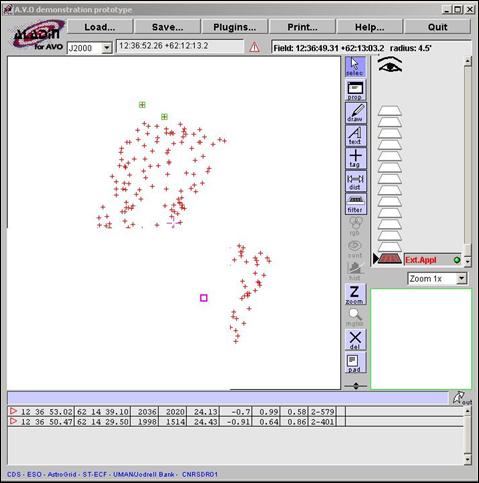
Interoperability between VOPlot and Aladin:
When points are selected in VOPlot, the corresponding objects are selected in Aladin. When the user selects objects in Aladin, the corresponding points get selected in VOPlot. When an object is highlighted in Aladin, the corresponding point in VOPlot is highlighted (the color of the point changes to red) as shown in Figure 29 below.
Figure 29
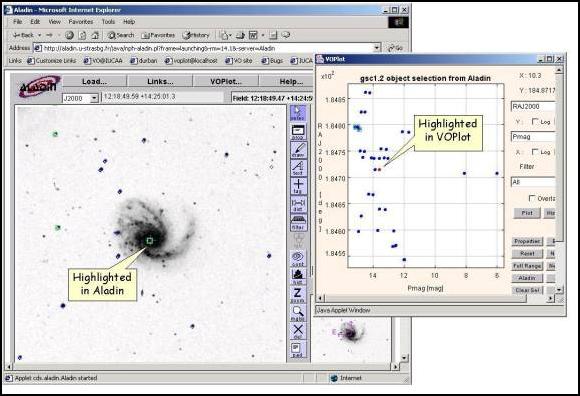
Feedback Address
We would be happy to receive any feedback/comments on VOPlot. For feedback and comments please contact voindia@vo.iucaa.ernet.in.



